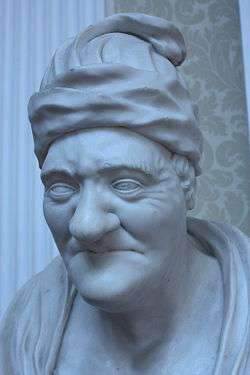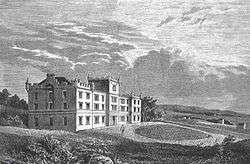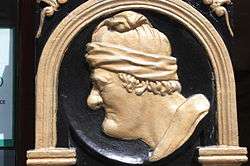James Gillespie (philanthropist)




James Gillespie (1726–1797) was a Scottish snuff and tobacco merchant in Edinburgh in the 18th century. He never married and when he died he left a fortune with the request that a hospital and school for the poor should be built.[1]
Life
James Gillespie was born in Roslin, Midlothian, south of Edinburgh, on 28 April 1726.[2]
He grew to fame and fortune in the city as a merchant, working with his younger brother John who ran the family shop. He had a snuff mill at Colinton employing many people, all of whom it is said were treated well. In 1773 he built Spylaw House, an impressive Georgian mansion house, as his home.[3] Most of his staff lived in the house which was attached to his mill.
He was notoriously thrifty and is credited with inventing the phrase "waste not, want not".[4] though Henry Erskine, alluding to Gillespie's snuff-fortune, said of his handsome carriage, "Who would have thought it, that noses had bought it".
A tablet marks the site of his shop at 231 High Street on the Royal Mile.
He died on 8 April 1797 and is buried in a large enclosed vault on the north side of the church in Colinton Churchyard near his house. His brother had died five years earlier. Neither had married so there was no direct heir. He left an estate plus £12000, a huge sum in those days.
A large portion of this (£2700) was left for the establishment of a free school for the education of poor boys. This was founded in 1803. The school was to educate boys between the ages of six and twelve who were required to produce proof of their poverty and a certificate of good health.
Gillespie's Hospital was built on the site of Lord Bargenie's baronial mansion in Bruntsfield, which was demolished in 1800,[5] much to the chagrin of Henry Cockburn who claimed that the historic and picturesque edifice built originally by a branch of the Napier family had been "brutally obliterated" while "the idiot public looked on in silence".[6]
The hospital building was in turn demolished after long disuse and replaced by new apartment blocks for the elderly in 1975.
The hospital, intended to provide for the aged poor, had selection criteria for entry: any person who had worked for the brothers; any person with the surname Gillespie aged 55 or over; persons over 55 from Edinburgh or Leith. All had to be without private resources, "decent, godly and well-behaved".[7]
Gillespie's name is preserved today in the name of James Gillespie's High School, a co-educational state comprehensive school established in 1973.
Artefacts

- His original shop sign is held by the Museum of Edinburgh
- A large snuff jar from his house is held by Lady Stair’s House (the Writers' Museum).
References
- ↑
 Stephen, Leslie; Lee, Sidney, eds. (1890). "Gillespie, James". Dictionary of National Biography. 21. London: Smith, Elder & Co.
Stephen, Leslie; Lee, Sidney, eds. (1890). "Gillespie, James". Dictionary of National Biography. 21. London: Smith, Elder & Co. - ↑ http://www.edinburghs-war.ed.ac.uk/system/files/PDF_gillespies.pdf
- ↑ Buildings of Scotland: Edinburgh
- ↑ http://www.jamesgillespiesprimary.co.uk/our-school/school-history/
- ↑ C McKean, The Wrychtshousis, 'A Very Curious Edifice' in The Book Of The Old Edinburgh Club, New Series vol 3, Edinburgh 1994
- ↑ H Cockburn, Memorials Of His Time (1851), James Thin reprint 1977, pp.173-4 -- Cockburn alleged that Gillespie had disinherited his nearest relation "for the vanity of being remembered by a thing named after himself".
- ↑ Grant's Old and New Edinburgh
External links
James Gillespie tablet, High Street, Edinburgh